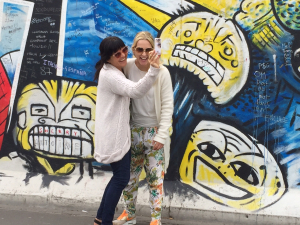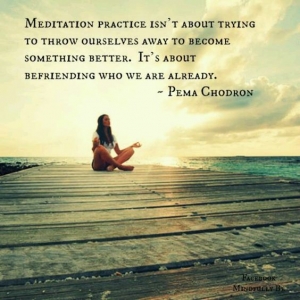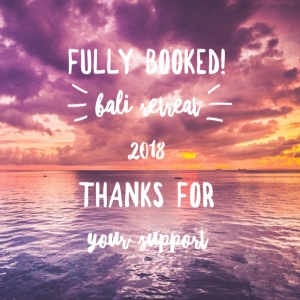
Displaying items by tag: healing
How Mental Healing Can Still Flourish in the Midst of COVID-19
By Breanna Pereira, NASM-Certified Personal Trainer and NASM-Certified Nutrition Coach - May 2020
How fitting that the anniversary of the acceptance of my depression would fall around Mental Health Awareness Month. Last year, I had paid no attention to it; this year, I am excited to pay homage to it. However, like most celebrations over the past couple of months, this will be spent with the looming effects of the global pandemic COVID-19. It’s hard to believe that it has almost been a year since I’ve had one of the most pivotal conversations of my young adult life—and it started with one simple question from a coworker:
“How are you really doing?”
This led me to admit to something I had been resisting for almost 10 years: I have depression and I need professional help in order to overcome it. I had mastered the art of masking my mental distress, but I eventually learned that masking is not a cure. It was a painful combination of fear, shame, and resistance.
As a health fitness specialist in the San Francisco/Bay Area, I am supposed to be the hype (wo)man. The one who motivates others to want to make changes to increase their quality of life, but that goes far beyond a number on a scale. It also entails the social, emotional, and spiritual aspects of life. I realized that if I wanted to be authentic in my career, it was going to require me to step outside of myself and seek help. In order to celebrate change, and to encourage it in others, I needed to embrace it wholeheartedly in my own life first.
I remember sitting in the waiting room of my therapist’s office and filling out the initial assessment forms.
Circle what applies to you.
Circling depression is what made it all real.
Overcoming the Stigmas Around Mental Health
Depression is something that I’ve known has always lived inside of me, but I was too afraid to say it out loud. I was afraid of the stigma that comes with the words: depression, anxiety, and therapy.
After a handful of sessions, my therapist helped me realize that those stigmas would only become a reality if I chose to breathe life into them. I have to constantly remind myself that I am on a journey of self-discovery, understanding, and self-compassion.
As a “recovering perfectionist and an aspiring ‘good-enoughist’” (thank you, Brené Brown), this has been an incredibly difficult year for me. Taking the time to chip away these walls I have built and become comfortable with openness and transparency is one of the scariest things I have ever done, but knowing that I have been able to overcome each fall by embracing and learning from each situation were signs of growth.
That growth has been tested daily since the start of this pandemic. Not only have I had to call on existing tools to preserve the progress that I’ve made, but I have also been pushed to develop new tools to help overcome the challenges that have risen over the past seven weeks. The biggest question that needed to be addressed: What if I can’t handle this anymore? Will that mean that all the progress I’ve made over the past year will have been for nothing?
In an attempt to calm my anxious mind, I have been able to uncover one of the most important tools: reflection. Now is the time to reflect on just how far I’ve come and to start actively developing a routine that utilizes each of the tools I have learned over the past year. While everyone is different and deals with their journeys of self-discovery and mental health differently, these are some tools that have helped me when I’ve recognized it’s time for action.
1. Read
By reading an hour before bed, I am able to give my mind an opportunity to escape our crazy pandemic reality and to start exploring new techniques to facilitate growth. These are some books that ha ve helped to provide that for me:
ve helped to provide that for me:
- Dare to Lead by Brené Brown
- A Woman Is No Man by Etaf Rum
- Gods of Jade and Shadow by Silvia Moreno-Garcia
- Daring Greatly by Brené Brown (currently reading)
2. Journal
I found a journal that has “BLOOM” written across the cover. For me, this serves as a reminder that the “blooming” process takes time, and that the environment I create will determine whether I will wilt or bloom. I don’t journal every day because a strict regimen in regard to self-expression creates a toxic perfectionist monster in my mind. Instead, I use this tool when I need a place to vent, to remind myself that I am strong, but that I don’t need to have everything figured out right now.
3. Exercise
Today, not only is fitness my career, but it has also become a physical representation of growth and success. I have a personal trainer. He and the rest of the Red Dot Fitness community have helped me uncover strength that I didn’t realize I had. By having a place where I can be surrounded by inspiring and passionate individuals, I always walked out of there feeling renewed.
During these weeks of quarantine, they have still been able to provide this sense of revival for me through live workouts and personal training sessions. They have been able to provide a sense of community even during this time of social distancing.
4. Meditate
In the past, I had tried to implement meditation into my routine, but it never worked because my approach to meditation was all wrong. The idea of being and remaining present is difficult for a naturally anxious perfectionist like me, but the guided meditations from Headspace have taught me that it is natural for the mind to go off track. Actively navigating my thoughts and emotions, when times get hard, is something I never thought I had the strength to do.
Every tool in my toolbox may seem quite simple, but what makes them highly effective is that I’ve discovered how and why they give me strength. I’ve allowed myself to gain a better sense of self-compassion, a working understanding of the importance of communication, and the power that arises when you take the time to slow down and breathe—and it’s hard to believe that it all started with one simple question of how am I really doing?
Recognizing your mental state, and then healing, doesn’t happen overnight; it is an ever-growing process. I hope that by sharing in my story you might allow others some room to breathe and practice being kind to yourself--especially during these trying times. While I may be celebrating one year of healing this month, practicing and respecting your mental health is a lifelong commitment, and I will forever be walking that journey alongside you.
I am enough, I am so enough, it's unbelievable how enough I am
Meditation as Medicine
Would you take a daily pill if it was scientifically proven to benefit your brain by increasing focus; reducing stress, anxiety, and depression; and improving memory, emotional awareness, and overall happiness? What if it wasn’t through taking a pill, but simply the act of sitting still, for even just one minute a day?
This week’s guest on The Doctor’s Farmacy is here to share that it is, in fact, possible to reap huge benefits in a short amount of time. Journalist and ABC news anchor Dan Harris turned his life around using the power of mindfulness and meditation; he was able to stop self-medicating with drugs, end his struggle with panic attacks, and focus on building a successful, balanced life instead.
Initially, Dan was a skeptic of the power of meditation. He didn't think science could back up the benefits… until he saw the research for himself.
Studies show that meditation works, in part due to its role in growing the beneficial grey matter in the brain, and Dan witnessed the effects himself once he gave it an honest try. His experience led him to write two New York Times best-selling books on the topic in an effort to help other fidgety skeptics embrace the medicinal properties of meditation.
Throughout our talk, Dan explains the proven impacts of meditation with a down-to-earth perspective and provides realistic steps for how to incorporate it into your own life, one minute at a time.
Dan shares his personal journey, from experiencing a panic attack on-air in front of millions to becoming a calmer, more mindful person, on this episode of The Doctor’s Farmacy. If you’ve ever wondered if meditation really works and just what the science says, this episode is for you.
I know you’ll enjoy it as much as I did.
Wishing you health and happiness,
Mark Hyman, MD
Beautiful Bali Is Calling
Connecting with Nature to gain Optimal Wellness
Deep Ties to the Earth: How One Northern Cree Tribe Finds Peace of Mind

Mybona/Thinkstock
A new study reveals that the community’s strength and resilience are tied to the people’s spiritual openness, community engagement, and connection to the land.
Only when the last tree has died and the last river been poisoned and the last fish been caught will we realize we cannot eat money. — Cree Proverb
In northern Ontario, near Hudson Bay, lies a remote, fly-in only Cree community with significantly lower rates of depression and suicide than other aboriginal communities in the area. In an effort to understand why this is so, a couple of researchers obtained grant funding, ventured into the area and asked the community members themselves. The findings of their study are published in the International Journal of Mental Health and Addiction.
The researchers wanted to avoid the Western medical model of focusing on pathology, or illness, alone, so they chose to interpret the participants’ responses according to the “medicine wheel” of traditional healing. This wheel reflects the four dimensions of the self (mental health, physical health, emotional health and spiritual health) as equal parts of a larger whole.
Overall, the findings reveal that the community’s strength and resilience in all four of these areas of health are tied to the people’s spiritual openness, community engagement, shared parenting, and perhaps most notably—a very deep connection to the land and traditions. In fact, most striking to the researchers was the way in which a connection to the land was interwoven throughout all of their responses.
For example, the community members said that their practice of harvesting and hunting their own food provides them with several important benefits: healthy meals, physical exercise and a connection to Cree traditions and cultural practices. They also believe in the importance of benefiting from the entire animal with one respondent saying “when people just harvest this for the sake of the meat and throw away a lot of stuff…they’ve lost their culture totally.”
Seeing wild animals on a regular basis is another fantastic perk, and the land is open and free, allowing people to feel comfortable where they are. In what was perhaps a particularly telling response, one participant said that the community did not “administer social assistance” as it has the potential to make “people totally quit from living off the land.”
The land itself is considered a source of spiritual renewal and healing. The respondents spoke of having a way of life that is still in touch with the natural flow and rhythm of wildlife. A majority referred to their relationship with the earth as a spiritual connection: “when you’re there, it’s like your spirit, your mind, and your physical well-being – everything improves when you’re out there; it’s like you rejuvenate while you’re out there.”
Perhaps the rest of us can learn from these important findings as well and give us substantial food for thought: How disconnected do you feel from the land? Do you take long random walks in nature? Do you see animals on the regular? Do you garden—or at least know where your food comes from? If not, make an effort this week to forge a deeper connection to the earth. Perhaps you will notice a different state of mind—and even a little peace of mind.
Traci Pedersen is a professional freelance writer who specializes in psychology, science, health, and spiritual themes. Some of her most recent work includes covering the latest research news in science and psychology, writing science chapter books for elementary students, and developing teacher resource books. When she is not researching and writing, she is spending time with her family, reading anything and everything, and going to the beach as often as possible.
Contact Leonie Main
m: +64 (0) 274 96 96 33
19B Golf Road, Mount Maunganui 3116, New Zealand
Facebook: Gypset Life






